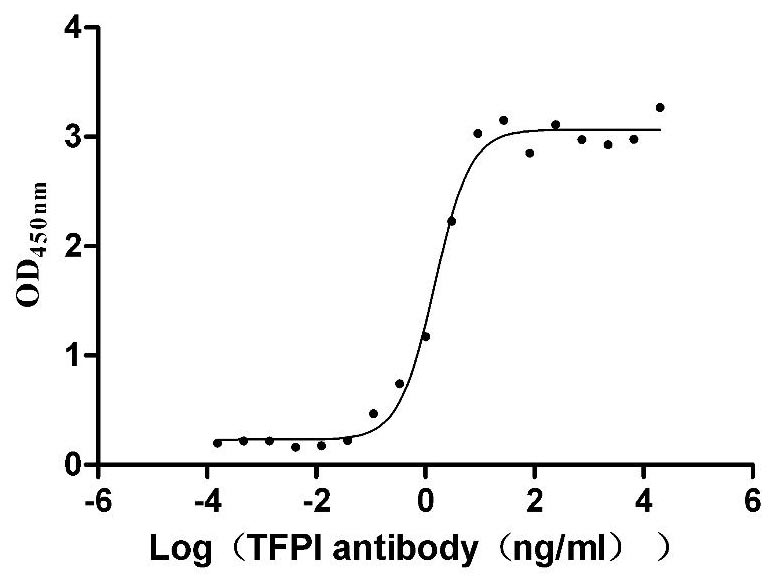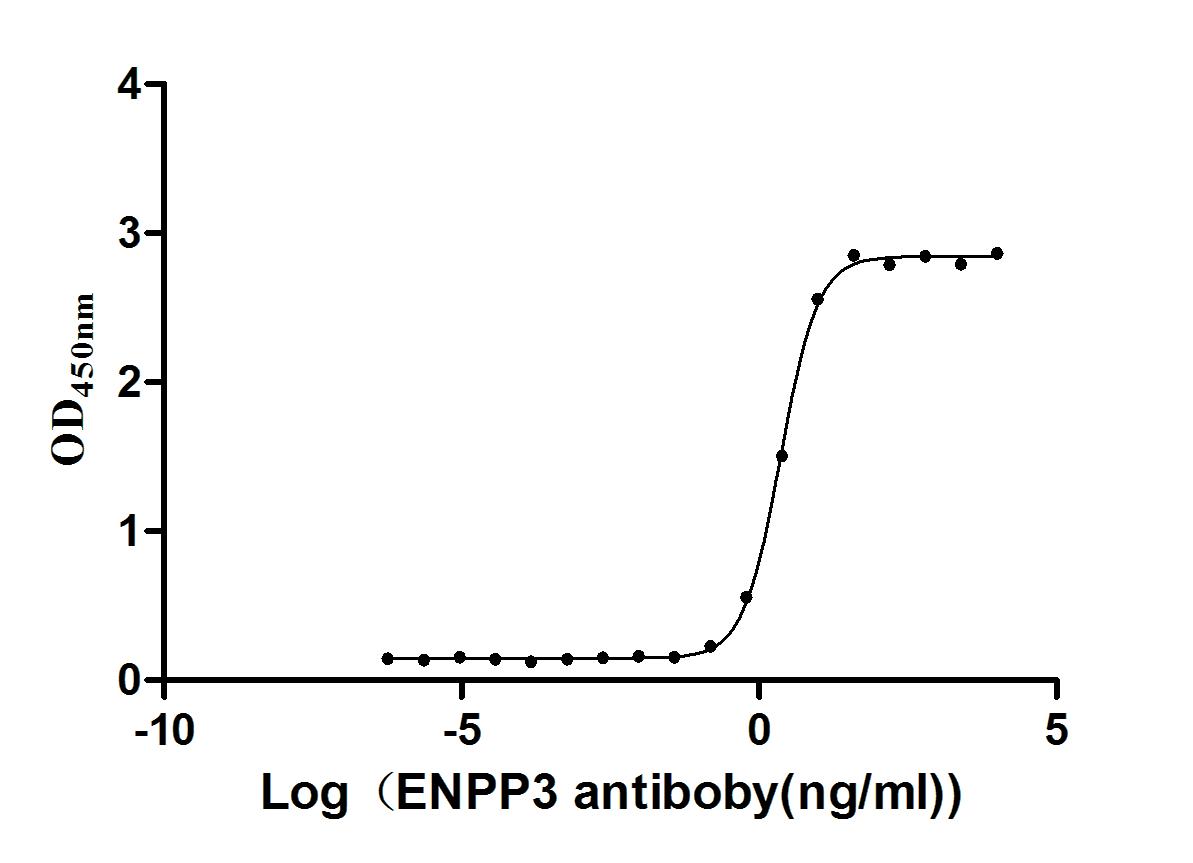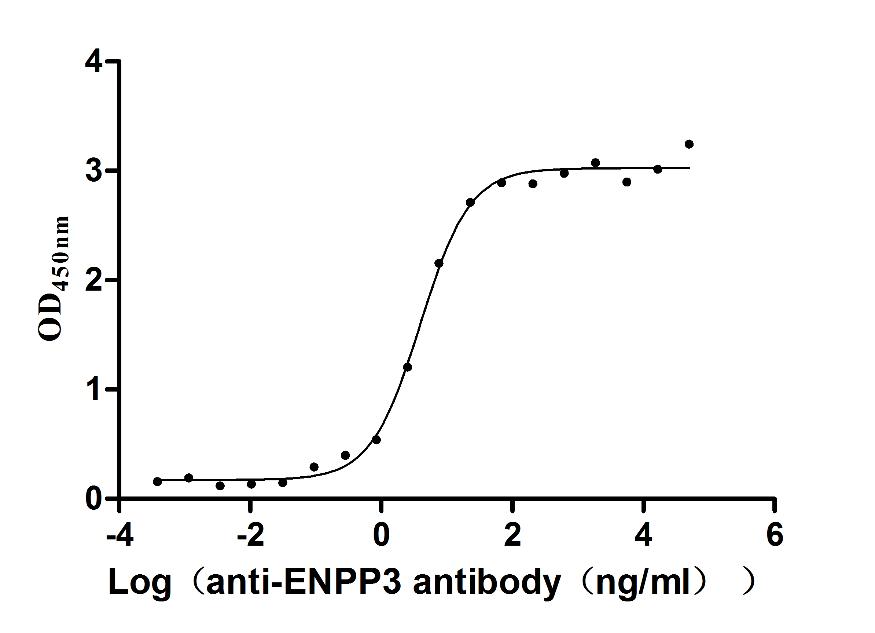Recombinant Mouse Paired box protein Pax-2 (Pax2)
-
中文名称:小鼠Pax2重组蛋白
-
货号:CSB-YP017488MO
-
规格:
-
来源:Yeast
-
其他:
-
中文名称:小鼠Pax2重组蛋白
-
货号:CSB-EP017488MO
-
规格:
-
来源:E.coli
-
其他:
-
中文名称:小鼠Pax2重组蛋白
-
货号:CSB-EP017488MO-B
-
规格:
-
来源:E.coli
-
共轭:Avi-tag Biotinylated
E. coli biotin ligase (BirA) is highly specific in covalently attaching biotin to the 15 amino acid AviTag peptide. This recombinant protein was biotinylated in vivo by AviTag-BirA technology, which method is BriA catalyzes amide linkage between the biotin and the specific lysine of the AviTag.
-
其他:
-
中文名称:小鼠Pax2重组蛋白
-
货号:CSB-BP017488MO
-
规格:
-
来源:Baculovirus
-
其他:
-
中文名称:小鼠Pax2重组蛋白
-
货号:CSB-MP017488MO
-
规格:
-
来源:Mammalian cell
-
其他:
产品详情
-
纯度:>85% (SDS-PAGE)
-
基因名:Pax2
-
Uniprot No.:
-
别名:Pax2; Pax-2; Paired box protein Pax-2
-
种属:Mus musculus (Mouse)
-
蛋白长度:Full length protein
-
表达区域:1-414
-
氨基酸序列MDMHCKADPF SAMHRHGGVN QLGGVFVNGR PLPDVVRQRI VELAHQGVRP CDISRQLRVS HGCVSKILGR YYETGSIKPG VIGGSKPKVA TPKVVDKIAE YKRQNPTMFA WEIRDRLLAE GICDNDTVPS VSSINRIIRT KVQQPFHPTP DGAGTGVTAP GHTIVPSTAS PPVSSASNDP VGSYSINGIL GIPRSNGEKR KREEVEVYTD PAHIRGGGGL HLVWTLRDVS EGSVPNGDSQ SGVDSLRKHL RADTFTQQQL EALDRVFERP SYPDVFQASE HIKSEQGNEY SLPALTPGLD EVKSSLSASA NPELGSNVSG TQTYPVVTGR DMTSTTLPGY PPHVPPTGQG SYPTSTLAGM VPGSEFSGNP YSHPQYTAYN EAWRFSNPAL LSSPYYYSAA PRGSAPAAAA YDRH
-
蛋白标签:Tag type will be determined during the manufacturing process.
The tag type will be determined during production process. If you have specified tag type, please tell us and we will develop the specified tag preferentially. -
产品提供形式:Lyophilized powder
Note: We will preferentially ship the format that we have in stock, however, if you have any special requirement for the format, please remark your requirement when placing the order, we will prepare according to your demand. -
复溶:We recommend that this vial be briefly centrifuged prior to opening to bring the contents to the bottom. Please reconstitute protein in deionized sterile water to a concentration of 0.1-1.0 mg/mL.We recommend to add 5-50% of glycerol (final concentration) and aliquot for long-term storage at -20℃/-80℃. Our default final concentration of glycerol is 50%. Customers could use it as reference.
-
储存条件:Store at -20°C/-80°C upon receipt, aliquoting is necessary for mutiple use. Avoid repeated freeze-thaw cycles.
-
保质期:The shelf life is related to many factors, storage state, buffer ingredients, storage temperature and the stability of the protein itself.
Generally, the shelf life of liquid form is 6 months at -20°C/-80°C. The shelf life of lyophilized form is 12 months at -20°C/-80°C. -
货期:Delivery time may differ from different purchasing way or location, please kindly consult your local distributors for specific delivery time.Note: All of our proteins are default shipped with normal blue ice packs, if you request to ship with dry ice, please communicate with us in advance and extra fees will be charged.
-
注意事项:Repeated freezing and thawing is not recommended. Store working aliquots at 4°C for up to one week.
-
Datasheet :Please contact us to get it.
靶点详情
-
功能:Transcription factor that may have a role in kidney cell differentiation.
-
基因功能参考文献:
- Paired box protein Pax-2 (Pax2)EGFP expression indicates the location of hair cells at the organoid region. PMID: 29272992
- results identify the LSD1/NuRD complex as a previously unrecognized modulator for Pax2-mediated neuronal differentiation in the inner ear PMID: 29370269
- Demonstrate the stepwise emergence of hitherto undescribed, differently Pax2/Pax8- coded anterior and posterior subdomains in the posterior placodal area of mice. PMID: 28160066
- Mutant p53 and PTEN loss negatively regulated PAX2 and PAX2 re-expression in high-grade serous ovarian cancer cells induced cell death. PMID: 27991925
- Pax2 function maintains nephron progenitor cells by repressing a renal interstitial cell program. PMID: 28535371
- PAX2 may not be a classical oncogene or tumor suppressor but instead can act in either role by differential regulation of COX2 and/or HTRA1. PMID: 26373819
- Pax2 specifies the intermediate mesoderm and renal epithelial cells through epigenetic mechanisms and in part by repressing paraxial mesodermal fate. PMID: 25617721
- the role of Pax2 protein levels in determining correct renal architecture and cell fate in urogenital development. PMID: 22410172
- cross-talk between p53 and Pax2 provides a transcriptional platform that promotes nephrogenesis, thus contributing to nephron endowment PMID: 22984579
- Hnf1b and Pax2 operate to control kidney morphogenesis and ureter differentiation. PMID: 22511595
- Hyperactivated Wnt signaling increased expression of the transcription factor Pax2 in the cells lining cysts in autosomal dominant polycystic kidney disease. PMID: 22677559
- Pax2 is essential for mouse development and regulates prostatic ductal growth, branching, and lobe-specific identitiy. PMID: 21594883
- These results suggest that PAX2 is a strong candidate gene for cases in which human patients have optic disc coloboma not associated with renal dysplasia. PMID: 20943750
- A high incidence of urinary tract anomalies in Pax2;Emx2 were found in compound heterozygous mice that are not found in single heterozygous mice. PMID: 21731775
- Atoh1 (Pax2-Cre) CKO mice undergo a rapid change of the embryonic prosensory epithelium through exaggerated cell death that results in near complete cellular loss of the organ of Corti PMID: 21146598
- Study shows that Pax2;8 double null mice do not develop an ear past the otocyst stage and no sensory and limited neuronal development; these 2 family members are essential for overall ear morphogenesis and sustained neurosensory development. PMID: 20727173
- The expression profile of PAX2 indicates that it may regulate early, androgen-independent stages of murine prostate development, particularly for dorsally derived prostate glands. PMID: 20017165
- PAX2 has a role in urogenital tract development and disease [review] PMID: 12141441
- Pax-2/RB binding reverses repression of Rig-1 protein. PMID: 12200151
- The origin of the inner ear defects in Shh(-/-) embryos could be traced back to alterations in the expression of a number of genes involved in cell fate specification including Pax2. PMID: 12231626
- findings demonstrate that Pax-2 is not essential for the developmental formation of islet A or gut L cells and does not play a role in the physiological control of proglucagon gene expression in vivo PMID: 12351699
- these data identify Pax2 and Pax8 as critical regulators that specify the nephric lineage. PMID: 12435636
- Results demonstrate that the redundant activities of Pax2 and Pax6 direct the determination of retinal pigment epithelium. PMID: 12756174
- Pax2 protein regulates expression of secreted frizzled related protein 2 PMID: 14561758
- WT1 and Pax2 can form a molecular complex, WT1 is a modifier of the Pax2 mutant phenotype. PMID: 14603255
- Pax2 may be implicated in the prenatal determination of the relative proportion of the endocrine and exocrine tissues of the pancreas. PMID: 15012626
- Pax-2 expression is increased in fetal kidney cells by angiotensin II via the AT2 receptor PMID: 15153556
- Pax2 plays a key role in regulating the differential growth within the cochlear duct and thus, its proper outgrowth and coiling PMID: 15242798
- the regulation of SOX2 (and SOX1/3) and its partner factors, exemplified by Pax6, determines the spatio-temporal order of the occurrence of cell differentiation [review] PMID: 15558474
- (i) Pax2 is expressed in normal renal medulla, (ii) its expression is regulated there by the normally high and variable NaCl concentration, and (iii) it protects renal medullary cells from high NaCl concentration-induced apoptosis. PMID: 15623552
- a key function of PAX2 is to activate WNT4 gene expression in metanephric mesenchymal cells as they differentiate to form elements of the renal tubules PMID: 16368682
- Mouse fetal kidney explants from PAX2+/- mice exposed to cisplatin showed 50% increases in apoptosis. PMID: 16609680
- Activation of PAX2 in healthy adult animals resulted in renal disease within 3 weeks after podocyte-specific induction of a deleter Cre. PMID: 16631587
- in Pax2 mutant mice, suppression of ureteric bud apoptosis rescues nephron endowment and adult renal function PMID: 16672320
- These observations define Pax2 as a marker expressed in basket and stellate cells, from around their final mitosis to their incipient histogenetic integration. PMID: 16903854
- These results show that, while Eya1 exerts an early function essential for normal growth and patterning of the otic epithelium, it also functionally synergizes with Pax2 during the morphogenesis of all sensory areas of mammalian inner ear. PMID: 16916509
- High glucose-induced Pax-2 gene expression is mediated, in part, via ROS generation and activation of the nuclear factor kappa B signaling pathway, but not via protein kinase C, p38 mitogen-activated protein kinase (MAPK), and p44/42 MAPK signaling. PMID: 16985513
- Pax2 is necessary for c-Ret expression in the developing kidney. PMID: 17047028
- PAX2 is rapidly reactivated in unilateral ureteral obstruction and mice with genetically limited PAX2 expression have heightened susceptibility to apoptosis PMID: 17164400
- a crucial role for Pax2 and Pax8 in nephron differentiation and branching morphogenesis of the metanephros. PMID: 17314325
- Pax-2 gene overexpression prevents hyperglycemia-induced apoptosis, and N-myc appears to provide a positive autocrine feedback on Pax-2 gene expression in embryonic mesenchymal cells. PMID: 17357786
- Mouse mutation has 30% incidence of vesico-ureteric reflux. Propensity to reflux in the Pax2 1Neu+/- mouse is correlated with a shortened intravesical ureter that has lost its oblique angle of entry into the bladder wall. PMID: 17881463
- PAX2 is important in determining axon number in mouse optic nerve. The developmental effects of tyrosinase and PAX2 mutation appear to act via different pathways. PMID: 18083586
- Pax2 is a downstream target of Ptf1a and controls subsets of transmitter phenotypes, including the expression of GlyT2, NPY, N/OFQ, DYN, and GAL, but is dispensable for SOM or ENK expression. PMID: 18634777
- Pax2 is expressed in populations of cells within the developing septum, hypothalamus, and eminentia thalami of mice. PMID: 18700968
- WNT5A is regulated by PAX2 and may be involved in blastemal predominant Wilms tumorigenesis PMID: 19048125
- Manipulation of genes in the inner ear with Pax2-Cre mice has provided information that has understanding of the mechanisms of otic induction. PMID: 19265685
- molecular properties of individual mouse Pax2 and Pax6 proteins are essential determinants of mouse eye development PMID: 19378250
- Data show that BMP7 and SHH activate Pax2 expression in mouse retinal astrocyte precursors in vitro, and that the interaction of both pathways with TLX relieves the repression of Pax2 expression in mouse retinal astrocytes. PMID: 19505455
显示更多
收起更多
-
相关疾病:Defects in Pax2 are a cause of developmental defects of the kidney, brain, ear and eye.
-
亚细胞定位:Nucleus.
-
组织特异性:Kidney and nephrogenic rests.
-
数据库链接:
KEGG: mmu:18504
UniGene: Mm.192158
Most popular with customers
-
Recombinant Human Tumor necrosis factor receptor superfamily member 1B (TNFRSF1B), partial (Active)
Express system: Mammalian cell
Species: Homo sapiens (Human)
-
Recombinant Human Tissue factor pathway inhibitor (TFPI), partial (Active)
Express system: Mammalian cell
Species: Homo sapiens (Human)
-
Recombinant Human G-protein coupled receptor family C group 5 member D (GPRC5D)-VLPs (Active)
Express system: Mammalian cell
Species: Homo sapiens (Human)
-
Recombinant Macaca mulatta Semaphorin-4D isoform 1 (SEMA4D), partial (Active)
Express system: Mammalian cell
Species: Macaca mulatta (Rhesus macaque)
-
Express system: Mammalian cell
Species: Homo sapiens (Human)
-
Express system: Mammalian cell
Species: Macaca fascicularis (Crab-eating macaque) (Cynomolgus monkey)
-
Recombinant Human Desmoglein-2 (DSG2), partial (Active)
Express system: Mammalian cell
Species: Homo sapiens (Human)
-
Recombinant Human Interleukin-2 receptor subunit alpha (IL2RA), partial (Active)
Express system: Mammalian cell
Species: Homo sapiens (Human)




















